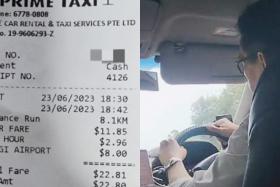Taxi vs UberX drivers: How different are they?
Will private car-sharing apps such as UberX and GrabCar see more regulation soon?
New Transport Minister Khaw Boon Wan mooted the idea of reviewing these apps to ensure a "level playing field".
In a blog post as the new minister of the often-troubled ministry, Mr Khaw wrote that during the campaigning for the recent General Election, he had met a number of taxi drivers who felt that such car-sharing apps such as UberX were unfair.

One of the reasons Mr khaw brought up in his blog post was the fact that Uber drivers do not require a vocational licence - unlike taxi drivers.
UberX users need not be worried yet as it appears that Mr Khaw is open to a more consultative approach towards regulating the industry.

He said that moves to ban the app in countries like Germany were an "over-reaction".
Mr Khaw also added: "We must not resist new innovations and new business models. Our instinct must be to flow with the time, keep an open mind to innovations. But we must always be fair to players, whether incumbent or insurgents, and strike a balanced approach."
Last Friday (Oct 2), Mr Khaw blogged that he had tasked Senior Minister of State for Transport Ng Chee Meng to study if private-hire drivers had an unfair advantage over taxi drivers since they “do not need a vocational licence”.
So what exactly are some of the key differences between UberX drivers and taxi drivers?
We take a look below.
1. Who can drive?
As Mr Khaw pointed out, while taxi drivers require a vocational licence, private hire drivers do not. And this has been a point of contention for taxi drivers.
According to the Land Transport Authority (LTA) website, taxi drivers undergo a training course at the Singapore Taxi Academy.
This course costs $335 - and takes about 95 hours to complete.
This vocational licence is valid for three years.
One of the issues the LTA is currently studying is whether to make private-hire drivers obtain vocational licences.
It must be noted that Uber drivers are not allowed to pick passengers up from the street or a taxi stand.
They have to be booked in advance via the app.
While taxi drivers have asked for licences to be made compulsory for private-hire drivers, Uber drivers have noted that the app asks for customers' ratings that can affect a driver's standing within the company.
Drivers who are not rated well can be suspended.
2. Rentals?
Generally, a taxi driver has to pay more rental than an Uber driver choosing to rent a car.
A taxi driver has to rent a taxi from any one of the seven taxi operators in Singapore. The rental rates vary according to the operator and the type of taxi.
Currently, they can range from $70 to $115 per day, according to latest figures on the LTA website.
However, past media reports have shown that rental costs are often above $100 and can go up to $135 for newer models of taxis.
Meanwhlie, Uber drivers can choose to drive their own car or rent a car.
To keep rental cost lows, companies like Uber and GrabCar have been snapping up used vehicles to grow their rental fleet.
An Uber driver who spoke to The Straits Times in June said he paid $65 a day to rent a Toyota Altis.
To drive their own car, this is what they need:
3) Earnings
Taxi drivers get to keep all of their earnings after taking into account rental and fuel.
On the other hand, Uber drivers get to keep 80 per cent of it while 20 per cent goes back to the company.
It's not clear who takes home more at the end of the day - it depends on the number of trips each person takes.
But both systems have its advantages and disadvantages.
It must also be noted that at most times, the price of booking an UberX comes close - or is sometimes cheaper - than a taxi.
4. Mileage
Unlike taxi drivers, UberX drivers are in complete control over the number of trips they want to take on.
In 2014, LTA introduced new requirements for taxi drivers to meet.
They would have to meet a daily minimum mileage of 250km on weekdays. And during the peak periods, 85 per cent of a taxi company's fleet must also be on the roads.
5. Incentives
While taxi drivers are imposed with a minimum requirement, UberX drivers are rewarded with incentives instead.
A look at the incentives for drivers on the Uber website shows that drivers are rewarded for making trips during peak hours.
For example: If a driver drove for 75 peak supply hours and made 1.9 trip per hour, he or she is guaranteed $2,700.
The peak hours during the weekdays are from 7am to 11am and 5pm to 11pm. And peak hours on weekends are from 10am to 10pm.
On top of that, there is also a loyalty incentive based simply on the number of trips made over a period of time.
If a driver made 100 trips per week for the last four weeks, the driver will earn $400.
Many taxis run on cheaper fuel such as natural gas - so taxi drivers tend to save on fuel compared with UberX drivers.
However, UberX drivers who drive their own cars are required by the company to show proof of a more comprehensive insurance meant for commercial purposes.
Rental companies which rent their cars to UberX drivers are also on comprehensive insurance.
Get The New Paper on your phone with the free TNP app. Download from the Apple App Store or Google Play Store now



